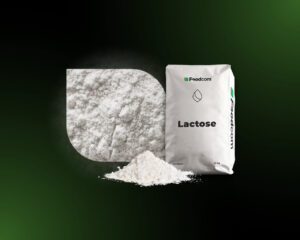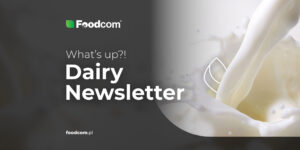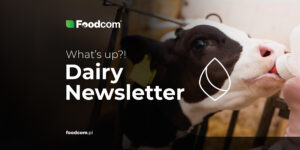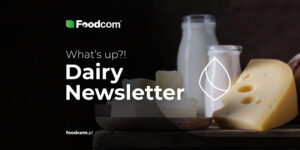- Mozzarella and cream prices in the EU are rising rapidly due to tight supply and strong industrial and retail demand.
- Butter and AMF prices in Europe remain high, with growing competition for raw materials, especially in the eastern part of the continent.
- The market for milk powder (SMP) and whey (SWP) is showing signs of recovery, mainly thanks to exports and limited availability of raw materials.
- Hard cheeses, such as Gouda and Cheddar, are stabilizing prices, although low stocks and limited supply of young cheese continue to affect the market.
Welcome Partners!
Welcome back to our newsletter!
Dairy prices in Europe continue to react to limited supply and seasonal changes, with contracts for the third quarter signalling possible further increases. Price stabilisation in some segments, such as feed SMP (skimmed milk powder) and cheddar, contrasts with price increases for mozzarella, butter and cream. Instability in global markets – from Europe to Oceania – and disruptions in production and international trade are shaping the current situation. In this review, you will find the latest price data, market commentary and information from key regions that may influence purchasing and contracting decisions in the coming weeks.
Milk powder
Prices of SMP for food purposes increased in Eastern Europe, reaching 2400-2430 EUR/MT respectively. Slight increases were also recorded in India and the United States. These increases are mainly due to the limited availability of raw materials and the gradual recovery of demand in export markets.
SMP prices for feed remained stable in the EU at 2380-2400 EUR/MT, despite slightly higher market activity in Oceania and the United States. Price movements are limited and sellers remain cautious, waiting for clearer signals from demand.
In Q3, SMP prices for feed are higher at 2450-2500 EUR/MT.
Cheese
Gouda prices have increased slightly due to a recovery in purchases in Q3. Production remains high in major markets such as the Netherlands and Germany, but producers show no urgency to sell. Low stock levels and the young age of the cheese continue to limit availability in the short term. Spot prices are currently around 4350 EUR/MT, with contracts for Q3 being signed at 4400 EUR/MT.
Mozzarella prices continue to rise due to increased demand from both retail and industrial buyers. Many buyers delayed entering into futures contracts in anticipation of seasonal price weakness, but they are now returning to the spot market, which remains tight. European prices have reached 4150 EUR/MT, while US prices remain lower at around 3800 EUR/MT.
After recent declines, cheddar cheese prices have stabilised. Higher production in Ireland and Central and Eastern Europe is negatively impacting domestic markets and export potential remains limited due to aggressive US pricing. Current prices in the EU remain at 4650 EUR/MT.
Emmental cheese prices remain high, supported by solid demand in Q3 and stable retail sales. EU production is stable, but prices continue to reflect a premium over other semi-hard cheeses. The current market level is around 5100 EUR/MT.
Fats
EU butter prices increased slightly to 7300-7350 EUR/MT. The increase was more pronounced in Eastern Europe, indicating increasing competition for raw materials in this region. At the same time, decreases were recorded in Turkey and South America, suggesting pressure from local demand. In the United States and Oceania, prices remained stable, which may indicate that the market is approaching equilibrium. Activity in futures contracts was moderate, with no clear direction.
The AMF market in the EU remained stable, with prices unchanged from the previous week and holding at 8600 EUR/MT. In Oceania, there was an increase to around 6400 EUR/MT, which may be due to local restrictions on milk fat supplies. There were no significant changes in international trade, with market participants reporting limited spot availability.
Liquids
EU cream prices increased to 8400-8500 EUR/MT. Price increases were also reported in Oceania, where shortages of milk fat are beginning to intensify. The market remains tight, with lower milk supplies and high raw material costs limiting product availability. Further pressure on prices is expected in the coming weeks, especially in regions affected by warm weather.
SMC prices in the EU have risen to 1780-1800 EUR/MT. There is a noticeable reduction in raw material availability in Germany and the Netherlands, due to lower milk yields and a seasonal drop in supply. The market is responding to these changes with price increases, but trade volumes remain moderate.
Milk availability in Germany and France has declined again and spot prices are on an upward trend. Dairies in key production regions report difficulties in securing adequate volumes, especially for seasonal production. The market expects further price increases in the coming weeks.
Whey powder
SWP prices for consumption in the EU have increased, approaching 1030 EUR/MT. The market remains active, especially in Eastern Europe where domestic demand remains strong. Increases are also being recorded in Oceania and the US, which may influence future export competition. Trade remains liquid, but raw material availability is declining slightly.
EU feed SWP prices remain stable, although there are signs of upward pressure. In Eastern Europe, demand from compound feed producers is increasing, resulting in a slight increase in transaction levels. Export markets remain quiet, with most trade concentrated on local supplies.
The sweet whey concentrate market remains stable, with prices fluctuating between 250-350 EUR/MT FCA. Trading activity is moderate, with short-term contracts dominating.
The market for instant WPC 80 remains in an upward phase. Prices are gradually increasing, supported by continued demand from the sports nutrition and functional food sectors. Raw material availability is limited, especially in Western Europe, putting upward pressure on prices. Some producers declare limited capacity to fulfil new contracts with short delivery times.
What’s new?
Nigeria is importing dairy cows from Denmark to double domestic milk production in five years – from 700,000 to 1.4 million tonnes per year. This is in response to annual imports worth US$1.5 billion. Despite more than 20 million cows, the majority are low-yielding pastoral breeds. The government supports intensive breeding, new pastures and has launched a genetic strategy with FAO support. “We are not starting from scratch – we are building on the strength we already have” – emphasises Breeding Minister Idi Maiha.
New Zealand has no hope of opening the Indian market to dairy, even if a free trade agreement is reached, admitted chief negotiator Vangelis Vitalis. India has consistently excluded milk from all trade agreements, protecting its sector and millions of small farmers. Meanwhile, for New Zealand, dairy exports are a key pillar of the economy and the main hope of doubling exports by 2034. Negotiations are ongoing, but the golden era of global trade is coming to an end – and geopolitical uncertainty, high tariffs and protectionism are increasingly complicating the future for New Zealand farmers.
Australians face soaring prices for milk, butter and cheese – with up to 80% of dairy farmers facing the consequences of floods, drought and cyclones. The latest flooding in New South Wales has destroyed entire farms, washed out cattle and infrastructure, and many farmers are announcing they are leaving the industry. Industry organisations are warning that the lack of immediate relief and bureaucracy is exacerbating the crisis. Dairy prices are set to rise for at least six months, and Australia is already importing butter from New Zealand, leaving it vulnerable to high global prices.
![Dairy market on the move – milk powder, cheese and butter prices are rising [270th Edition of DAIRY Newsletter] Dairy market on the move – milk powder, cheese and butter prices are rising [270th Edition of DAIRY Newsletter]](https://foodcom.pl/wp-content/uploads/2023/08/Foodcom_SA_Whats_up_Dairy_Newsletter-1520x760.jpg)






